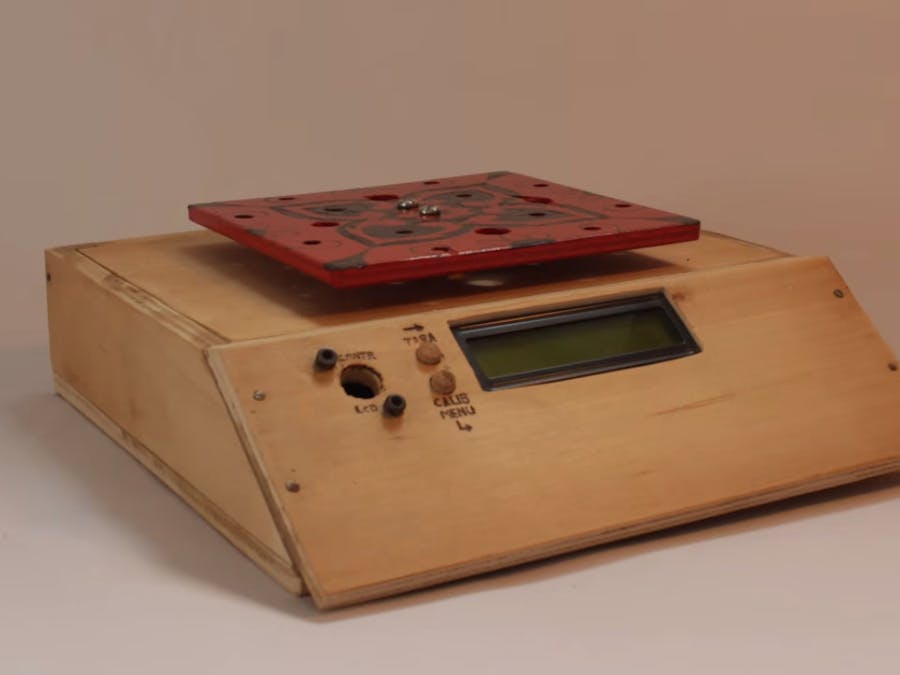Everyone needs a good scale in kitchen, what better than to build a high precision scale with the UNO?

Things used in this project
Hardware components
Hand tools and fabrication machines
Soldering iron (generic)
Wood
Screws
Story
I've worked on scale words since 2015 but the biggest challenge has always been to build something that i repair every day at work. So i decided to try it, I had an arduino UNO, a load cell and an LCD. After a long run, I decided to rely on a DFrobot hx711. After a bit of study on how to connect the converter I started writing code for calibration and for counting scale mode function using the knowledge gained at work. Surprisingly I realized I could achieve a high level of precision despite using only a cheap converter and a C3 load cell. And so after a little bit of filtering here is my ArduScale 2.0! :) P.S. I have calibrated the scale with F1 class precision weights and it passed all metrological tests.
Code
Arduino uno scale test
Arduino
The main software is divided into two parts, weighing and counting function.
During the boot animation I entered a subroutine for the scale calibration function. The calibration data is stored in the Euprom of Arduino for subsequent uses.
#include "HX711.h"
#include"math.h"
#include <EEPROMex.h>
#include <EEPROMVar.h>
#include <LiquidCrystal.h>
#define BUTTON 7
#define LED 13
#define TAREBUTTON 10
#define buzzer 8
// HX711.DOUT - pin #A2
// HX711.PD_SCK - pin #A3
LiquidCrystal lcd(12, 11, 5, 4, 3, 2);
HX711 scale(A2, A3); // parameter "gain" is ommited; the default value 128 is used by the library
long somma1=0;
float I=0;
int a;
float b;
float calibval1;
float calibval2;
float media2=0;
float media1=0;
long somma2=0;
float pmax= 900;
int val=0;
int val1=0; //valore del pulsante di tara
float t =0;
float g=0;
void setup() {
scale.set_scale();
scale.tare();
pinMode (buzzer, OUTPUT);
tone(buzzer,440,1000);
delay(500);
noTone(buzzer);
delay(200);
tone (buzzer,330,1000);
delay(1000);
noTone(buzzer);
Serial.begin (9600);
lcd.begin(16, 2);
lcd.print ("Fede Bil");
lcd.setCursor( 0,1);
lcd.print ("ver.1.0 :)");
for (int positionCounter = 0; positionCounter < 6; positionCounter++) {
// scroll one position left:
lcd.scrollDisplayRight();
// wait a bit:
delay(450);}
for (int positionCounter = 0; positionCounter < 6; positionCounter++) {
// scroll one position left:
lcd.scrollDisplayLeft();
// wait a bit:
delay(450);}
delay(3000);
lcd.clear ();
lcd.print ("Press Button 2");
lcd.setCursor(0,1);
lcd.print("to calibrate");
delay(1500);
pinMode(LED, OUTPUT);
pinMode (TAREBUTTON,OUTPUT); //IMPOSTA IL PULSANTE DI TARA
pinMode(BUTTON, INPUT); // imposta il pin digitale come input
val=digitalRead (BUTTON);
if (val==HIGH){
tone(buzzer,1047,1000);
digitalWrite(LED, HIGH);
calibrazione();}
else {
tone(buzzer,660,500);
Serial.println (EEPROM.readFloat(10)); // restituisce il valore float memorizzato all'indirizzo indicato Ricarica calibval1
calibval2= (EEPROM.readFloat(10));
Serial.print ("calibval2=");
Serial.println (calibval2);
scale.set_scale (calibval2);
}}
void loop() {
pippo: I= (scale.get_units(10));
Serial.println(I);
if (I < 1 &&I>0)
{ val1= digitalRead (TAREBUTTON);
if (val1==HIGH){
tone(buzzer,622,1000);
lcd.clear();
lcd.print ("Tara");
delay (1000);
t= scale.get_units(10);
g=round(t);
scale.tare();}
lcd.clear();
lcd.print("d=0,5g");
//lcd.setCursor(9,0);
lcd.setCursor(0,1);
lcd.print("0.00");
lcd.setCursor(9,0);
lcd.print ("d=0.2g");
lcd.setCursor (9,1);
lcd.print(I);
delay(500);
Serial.println ("0.00");
val=digitalRead (BUTTON);
if (val==HIGH){
tone(buzzer,1047,500);
digitalWrite(LED, HIGH);
menu();}
else {
}
goto pippo;
}
val1= digitalRead (TAREBUTTON);
if (val1==HIGH){
tone(buzzer,622,1000);
lcd.clear();
lcd.print ("Tara");
delay (1000);
t =scale.get_units(10);
g=round(t);
scale.tare();
val=digitalRead (BUTTON);
if (val==HIGH){
tone(buzzer,1047,500);
digitalWrite(LED, HIGH);
menu();}
else {
}}
int c= (I*10);
int e = (I*10);
// e=round (c);
int peso_div = (e+1)-((e+1)%2);
int peso_div_5 = (c+2)-((c+2)%5);
float f = (peso_div);
float peso2 = (f/10);
float d = (peso_div_5);
float pesofin=(d/10);
if (pesofin > pmax)
{tone(buzzer,1047,2000);
lcd.clear();
lcd.print ("Overload");
goto pippo;}
lcd.clear();
lcd.setCursor (0,0);
lcd.print ("d=0,5g");
lcd.setCursor(0, 1);
lcd.print (pesofin);
lcd.setCursor(9,0);
lcd.print ("d=0.2g");
lcd.setCursor (9,1);
lcd.print (peso2);
delay(150);
val=digitalRead (BUTTON);
if (val==HIGH){
tone(buzzer,1047,500);
digitalWrite(LED, HIGH);
lcd.clear();
menu();}
else {
}
}










